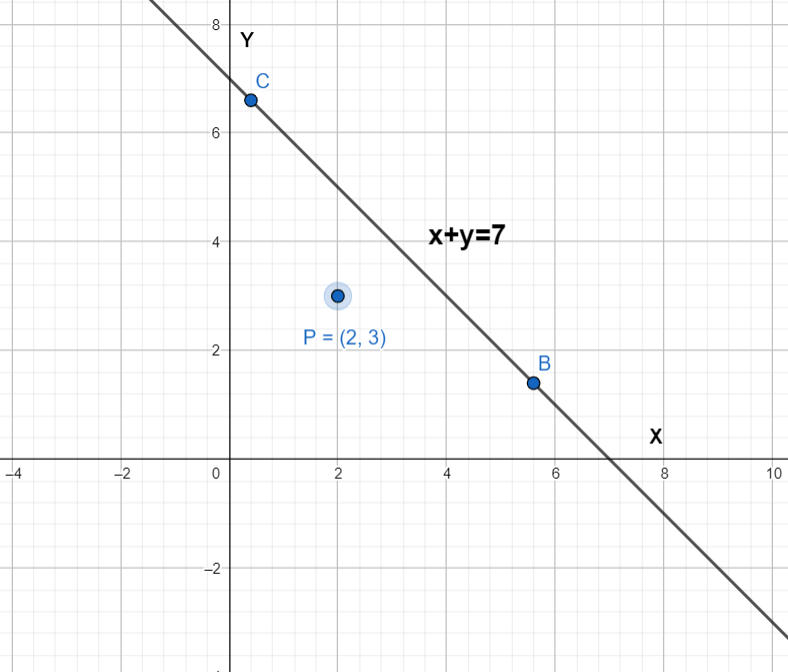Answer
404.7k+ views
Hint: The distance between the point of intersection and point P is 4. The point of intersection lies on the line $x+y=7$ . There will be 2 points on the line $x+y=7$ at a distance of 4 units from the point P. So we will get 2 values of slope.

Complete step-by-step solution:
In the above figure point given point P(2,3) has been shown and we have to find the point B and C which are 4 units from P and lies on line $x+y=7$
Then we have to find the slope of lines joining the point PB and PC.
The point of intersection will satisfy the equation of line $x+y=7$ and at a distance of 4 units from P(2,3).
So if we take x coordinate point is $\alpha $the y coordinate will be $7-\alpha $ .So the distance between $\left( \alpha ,7-\alpha \right)$ and P(2,3) is 4 units.
So, by applying distance formula
${{\left( \alpha -2 \right)}^{2}}+{{\left( 4-\alpha \right)}^{2}}=16$
$\Rightarrow $$2{{\alpha }^{2}}-12\alpha +20=16$
$\Rightarrow $${{\alpha }^{2}}-6\alpha +2=0$
By applying the formula $\dfrac{-b\pm \sqrt{{{b}^{2}}-4ac}}{2a}$ we can find the roots of the equation.
In the equation ${{\alpha }^{2}}-6\alpha +2=0$, a=1,b=-6 and c=2 so substituting these values in the above formula we get
$\dfrac{-b\pm \sqrt{{{b}^{2}}-4ac}}{2a}=$$\dfrac{6\pm \sqrt{{{\left( -6 \right)}^{2}}-4\times 1\times 2}}{2\times 1}$
$\begin{align}
& \Rightarrow \dfrac{6\pm \sqrt{{{\left( -6 \right)}^{2}}-4\times 1\times 2}}{2\times 1}=\dfrac{6\pm \sqrt{28}}{2} \\
& \Rightarrow \dfrac{6\pm \sqrt{28}}{2}=\dfrac{6\pm 2\sqrt{7}}{2}=3\pm \sqrt{7} \\
\end{align}$
Roots of the equation are $3+\sqrt{7}$ and $3-\sqrt{7}$
So values of $\alpha $ can be $3+\sqrt{7}$ and $3-\sqrt{7}$. The point of intersection can be $\left( 3+\sqrt{7},4-\sqrt{7} \right)$and$\left( 3-\sqrt{7},4+\sqrt{7} \right)$.
The slope of line joining 2 points $\left( {{x}_{1}},{{y}_{1}} \right)$ and $\left( {{x}_{2}},{{y}_{2}} \right)$ is $\dfrac{{{y}_{2}}-{{y}_{1}}}{{{x}_{2}}-{{x}_{1}}}$
Here in this case the slope of the line joining P and point of intersection will be
$\dfrac{\left( 4-\sqrt{7} \right)-3}{\left( 3+\sqrt{7} \right)-2}=\dfrac{1-\sqrt{7}}{1+\sqrt{7}}$ and $\dfrac{\left( 4+\sqrt{7} \right)-3}{\left( 3-\sqrt{7} \right)-2}=\dfrac{1+\sqrt{7}}{1-\sqrt{7}}$
So the answer will be option C- $\dfrac{1-\sqrt{7}}{1+\sqrt{7}}$.
Note: We can solve this question by other methods. We can assume the slope of the line is m; the point of intersection will be in linear term of m. Then we can apply the distance formula from point P to point of intersection and the equation will be quadratic. So we will get 2 values of m. Another method is we can take the point of intersection $\left( 2+4\cos \theta ,3+4\sin \theta \right)$ where $\tan \theta $ is the slope of line. $\left( 2+4\cos \theta ,3+4\sin \theta \right)$ Will lie on line $x+y=7$.Then we can find the value of $\tan \theta $ .

Complete step-by-step solution:
In the above figure point given point P(2,3) has been shown and we have to find the point B and C which are 4 units from P and lies on line $x+y=7$
Then we have to find the slope of lines joining the point PB and PC.
The point of intersection will satisfy the equation of line $x+y=7$ and at a distance of 4 units from P(2,3).
So if we take x coordinate point is $\alpha $the y coordinate will be $7-\alpha $ .So the distance between $\left( \alpha ,7-\alpha \right)$ and P(2,3) is 4 units.
So, by applying distance formula
${{\left( \alpha -2 \right)}^{2}}+{{\left( 4-\alpha \right)}^{2}}=16$
$\Rightarrow $$2{{\alpha }^{2}}-12\alpha +20=16$
$\Rightarrow $${{\alpha }^{2}}-6\alpha +2=0$
By applying the formula $\dfrac{-b\pm \sqrt{{{b}^{2}}-4ac}}{2a}$ we can find the roots of the equation.
In the equation ${{\alpha }^{2}}-6\alpha +2=0$, a=1,b=-6 and c=2 so substituting these values in the above formula we get
$\dfrac{-b\pm \sqrt{{{b}^{2}}-4ac}}{2a}=$$\dfrac{6\pm \sqrt{{{\left( -6 \right)}^{2}}-4\times 1\times 2}}{2\times 1}$
$\begin{align}
& \Rightarrow \dfrac{6\pm \sqrt{{{\left( -6 \right)}^{2}}-4\times 1\times 2}}{2\times 1}=\dfrac{6\pm \sqrt{28}}{2} \\
& \Rightarrow \dfrac{6\pm \sqrt{28}}{2}=\dfrac{6\pm 2\sqrt{7}}{2}=3\pm \sqrt{7} \\
\end{align}$
Roots of the equation are $3+\sqrt{7}$ and $3-\sqrt{7}$
So values of $\alpha $ can be $3+\sqrt{7}$ and $3-\sqrt{7}$. The point of intersection can be $\left( 3+\sqrt{7},4-\sqrt{7} \right)$and$\left( 3-\sqrt{7},4+\sqrt{7} \right)$.
The slope of line joining 2 points $\left( {{x}_{1}},{{y}_{1}} \right)$ and $\left( {{x}_{2}},{{y}_{2}} \right)$ is $\dfrac{{{y}_{2}}-{{y}_{1}}}{{{x}_{2}}-{{x}_{1}}}$
Here in this case the slope of the line joining P and point of intersection will be
$\dfrac{\left( 4-\sqrt{7} \right)-3}{\left( 3+\sqrt{7} \right)-2}=\dfrac{1-\sqrt{7}}{1+\sqrt{7}}$ and $\dfrac{\left( 4+\sqrt{7} \right)-3}{\left( 3-\sqrt{7} \right)-2}=\dfrac{1+\sqrt{7}}{1-\sqrt{7}}$
So the answer will be option C- $\dfrac{1-\sqrt{7}}{1+\sqrt{7}}$.
Note: We can solve this question by other methods. We can assume the slope of the line is m; the point of intersection will be in linear term of m. Then we can apply the distance formula from point P to point of intersection and the equation will be quadratic. So we will get 2 values of m. Another method is we can take the point of intersection $\left( 2+4\cos \theta ,3+4\sin \theta \right)$ where $\tan \theta $ is the slope of line. $\left( 2+4\cos \theta ,3+4\sin \theta \right)$ Will lie on line $x+y=7$.Then we can find the value of $\tan \theta $ .
Recently Updated Pages
What are the figures of speech in the poem Wind class 11 english CBSE

Write down 5 differences between Ntype and Ptype s class 11 physics CBSE

Two tankers contain 850 litres and 680 litres of petrol class 10 maths CBSE

What happens when eggshell is added to nitric acid class 12 chemistry CBSE

Why was Kamaraj called as Kingmaker class 10 social studies CBSE

What makes elections in India democratic class 11 social science CBSE

Trending doubts
What is 1 divided by 0 class 8 maths CBSE

Which are the Top 10 Largest Countries of the World?

Differentiate between homogeneous and heterogeneous class 12 chemistry CBSE

The Equation xxx + 2 is Satisfied when x is Equal to Class 10 Maths

Difference between Prokaryotic cell and Eukaryotic class 11 biology CBSE

Fill the blanks with the suitable prepositions 1 The class 9 english CBSE

When did the NonCooperation Movement begin A August class 8 social science CBSE

Give 10 examples for herbs , shrubs , climbers , creepers

Who was the Congress President at the time when India class 9 social science CBSE



